GA4 MIGRATION RESOURCE CENTER
Step One: Implementation Planning
AT A GLANCE
Update your Measurement Strategy by completing the Business Goals Analysis Checklist.
Gain context for your implementation tasks by reviewing the data schema comparisons between UA and GA4.
Implementation Planning
Migrating a business to the latest Google Analytics platform can be overwhelming. Even after migration, the first weeks will be unfamiliar: a new UI, an event-based structure, a new reporting engine, and more. However, following a documented business-specific plan will make this far less confusing than simply jumping in and attempting to recreate all your legacy functions.
Key Tasks
- Assess current UA configuration to establish a baseline for GA4 implementation functionality
- Assess current business goals and the web/app tactics that support them to establish a GA4 Measurement Strategy
- Review the data schema differences between UA and GA4 to gain context for your implementation tasks
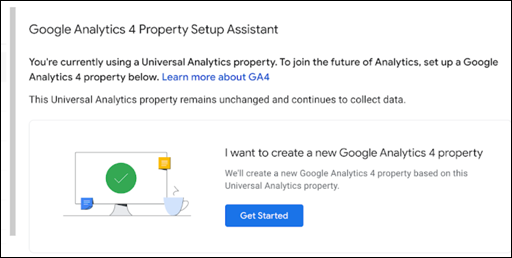 GA4 Setup Assistant
GA4 Setup Assistant
Overview
Changes to the analytics platform, and, equally important, changes to your business, require documenting your current state, your desired improved future state, and awareness of some of the rules, parameters, and structures required for the journey.
With your business-specific plan, the GA4 implementation can be a leap forward in your data science and digital marketing maturity.
- First, complete a quick inventory of your current UA configuration. Identify the current functions fulfilling your data analysis needs.
- Next, assess your business goals and how web and app tactics should support them. Create an updated measurement plan that supports the brand far better than your current approach does.
- Finally, become familiar with the functions and structure of the new platform. Gain the contextual knowledge that drives intelligent configuration decisions.
UA Configuration Assessment
Documenting the basics of your UA configuration is the beginning of your GA4 Migration blueprint. Use the UA Configuration Checklist below to capture all the basics in one place. Your team can reference the resulting baseline throughout the implementation, driving key decisions on choosing a tagging methodology, the multiple options for UA Goals Migration, and the critical customizations that must be carried forward. Click the image below to open.
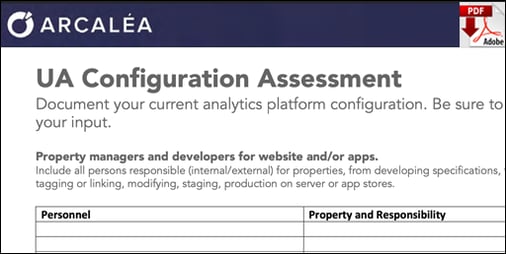 Open UA Configuration Checklist
Open UA Configuration Checklist
Business Goals Analysis
The property tactics built in GA4 must support and measure your identified business goals. Reviewing those goals and property tactics now allows you to update your measurement strategy, driving the maximum impact of your GA4 configuration. To recalibrate how property tactics are achieving business goals, ask key results-based questions:
- Am I using what I track or tracking because I could?
- Are the data points vanity metrics (e.g., followers, site hits) without quantified connection to revenue goals?
- Does the data provide specifics about the customer journey?
- Do I learn more about your prospects, their needs and behaviors?
Because the GA4 platform uses a completely new data schema and approach, some old capabilities are easier (or built-in), some are gone, and some new capabilities are possible. As a result, the migration creates an opportunity to revisit your measurement requirements driven by your goals, the property tactics that support them, and the KPIs that measure your success. Click the image below to open.
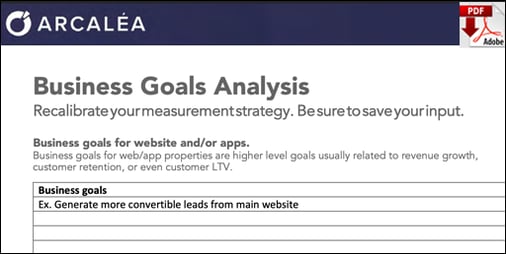 Open Business Goals Analysis Checklist
Open Business Goals Analysis Checklist
Getting Familiar with GA4
Whether you are the CMO or the Web Manager, becoming familiar with the new Google Analytics will benefit you and your business.
- Make implementation decisions that support your business
- Achieve business goals with minimum customization (or work effort)
- Take full advantage of the new platform features and structure
By first checking a structure and function overview to identify key differences, you can understand interconnected features and the dependencies involved.
Need help with implementation?
Data drives marketing audiences across GAds and eCommerce. Migrate now to build native GA4 customer data. We can help you get there.
A Configuration Example
GOAL: You need to migrate a specific UA goal that captures how users from two specific audiences interact with a specific content grouping.
After the property is set up and tagged, a custom event (i.e., not automatically collected) must be built using a custom dimension, which must be created separately. And since content groups are no longer built in the UI, all the pages in a content group must be tagged for that content group.
So, in this case, rebuilding one goal demands:
- Create content groups by tagging these pages or screens
- Create audiences using conditions in the audience builder
- Create custom event
- Create a custom dimension (and metric) that can be retrieved by GA4
- Select event as conversion
- Create a custom report to see results in a familiar fashion
A planning blueprint and high-level platform knowledge can ensure that nothing is lost from UA to GA4. An intentional configuration creates an analytics infrastructure which can enable multiple tactics of a business goal. For example, after building the above goal, you now have a reusable event, dimension and metric that can be used anywhere, content groups that can be referenced from any event or report, audiences that can be used throughout GA4 (and Google Ads if linked). And custom reports are the defining characteristic of the platform’s reporting UI.
UA Structure vs GA4 Structure
Google has created a body of accessible reference material which provides both high-level and deep dives of each functional area, often including how these relate to legacy UA components.
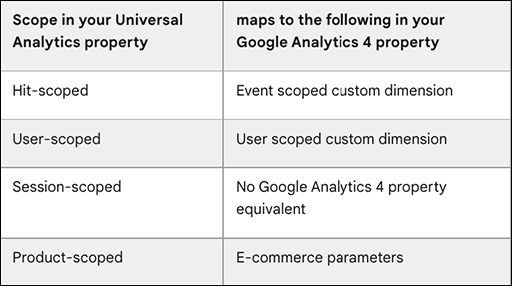 Custom Dimensions/Metrics Comparison
Custom Dimensions/Metrics Comparison
In UA, a primary unit was users and sessions, while in GA4 the focus shifts to users and events. The event_name + parameter structure derived from Firebase Analytics is a more flexible and agnostic data collection model. These structural changes drive everything from basic configuration options to how reports analyze your properties. While you can still capture just about everything tracked in UA, it’s done differently, and in some cases automatically (see automatically-collected events and enhanced measurement events). Start by reviewing the comparison articles below.
Data models comparison: UA and GA4 cover hit types, events, page/screen views, sessions, custom dimensions/metrics, content groupings, user ID/Client ID, parameters, user property, data collection settings to migrate, data collection settings that can’t migrate.
Metrics comparison: UA and GA4 detail users, page views, purchases, sessions, conversions, and how core metrics are calculated in the two platforms.
Tagging and collecting data in UA and GA4 includes differences, specific approaches (e.g., GTM), gtag.js mapping from UA to GA4, moving from analytics.js to gtag.js, and eCommerce data collection from UA to GA4.
GA hierarchical organization is mapped out from Organization to Data streams, with parallels to Firebase and Google Ads hierarchies. For example, a business is usually one account, representing the legal entity under one account with up to 100 properties.
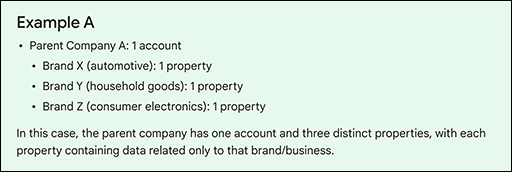 Large Company Account Hierarchy
Large Company Account Hierarchy
A property should include all of the data sources for a customer base or customer journey for the product or service. A single property can connect up to 50 data streams (web/app combination), with limits of 30 app streams. A property in GA4 is at the same hierarchy level as a Project in Firebase, while a data stream in GA4 maps to an app. Hence, multiple projects in Firebase would require multiple GA4 properties to link. A property is also the level at which you connect to your Google Ads account, whether sharing audiences or conversion data for bidding. An implementation can be structured any way that works for a business, but these guidelines can help as you organize your digital analytics components.
 Small Business Account Hierarchy
Small Business Account Hierarchy
Configuration limits across your configuration can also drive configuration and customization decisions. For example, each property may have a maximum of 100 audiences configured, 30 conversions configured, and 50 event-scoped custom dimensions.
Ready to grow?
Uncover customer journeys and accelerate conversion with GA4's advanced AI and data-driven attribution. We can help you get there.
GA Updates
Anyone who has worked with Google (or any MarTec) knows that platforms are constantly evolving. When GA4 launched, it came with Analysis Hub, which became “Explorations.” Individual elements, such as new dimensions and functions, continue to be added. Check all updates at the “What’s New” GA page. Because of the update frequency, you may discover some third-party resources still referencing old function names in posted video content.
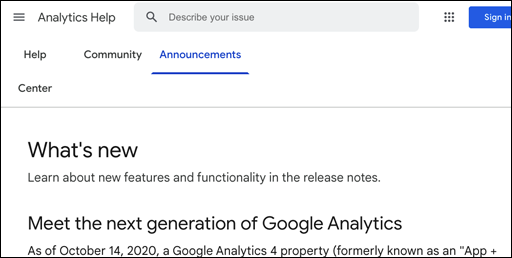 Google's Update Announcement Page
Google's Update Announcement Page
Using the GA4 Migration Center
Over the next two weeks, Arcalea will be adding sections to cover the most common (and critical) functional areas of a GA4 Migration. In each functional area, you will find:
- Tasks most common within a function, including task overview and key guidance used to complete common tasks, as well as links to examples.
- Resources are linked within the text and included at section end for reference. Google Analytics Help is linked throughout, as it is often the most current content. Where helpful, third-party content is linked which provides unique and task-specific insights and detailed steps to achieve configuration goals.
RESOURCES
Connected site tags: GA support explains how the tags work, and specific examples of limitations that can impact GA4 properties. Includes how to add or remove connected site tags.
Data models comparison: UA and GA4 covering hit types, events, page/screen views, sessions, custom dimensions/metrics, content groupings, user ID/Client ID, parameters, user property, data collection settings to migrate, data collection settings that can’t migrate
GA hierarchical organization is mapped out from Organization to Data streams, with parallels to Firebase and Google Ads hierarchies.
GA4 configuration limits list the maximum options per property for custom audiences, conversions, dimensions, and more.
GA4 Migration Reference covers the entire process for migrating from UA to GA4. Organized from planning through property setup and product linking, the support article includes copious links to Analytics Help articles on each element of the platform.
Manual property creation: GA support provides steps for manually creating a new property, from account to data stream.
Metrics comparison: UA and GA4 covering users, page views, purchases, sessions, conversions, and how core metrics are calculated in the two platforms
Setup Assistant walkthrough: GA support includes a step-by-step walkthrough of the process for creating a GA4 property with the wizard.
Structure your Analytics account: GA support article applies hierarchy across all elements of a new implementation, with example account and property structures.
Tagging and collecting data in UA and GA4 covering differences, specific approaches (e.g., GTM), gtag.js mapping from UA to GA4, moving from analytics.js to gtag.js, and eCommerce data collection from UA to GA4.
SERVICES
GA4 MIGRATION STEPS
STEP 1: IMPLEMENTATION PLANNING
Assess Your UA Configuration and Create Your GA4 Measurement Plan
STEP 2: PROPERTY
Create Property and Plan Tagging
STEP 3: TAGGING AND TRACKING
Connect Data Streams and Add GA4 Tags to Enable Data Collection
STEP 4: EXCLUSIONS AND FILTERS
Implement Exclusions and Filters to Maintain Clean User Data
STEP 5: GOALS MIGRATION
Map and Recreate UA Goals as GA4 Conversion Events
STEP 6: EVENTS
Map and Recreate Priority UA Events as GA4 Events
STEP 7: CONTENT GROUPING
Implement Content Groups with Tag Parameters and Variables
STEP 8: CUSTOM DIMENSIONS AND METRICS
Map and Recreate UA Dimensions and Metrics to GA4
STEP 9: AUDIENCES
Recreate UA Audiences by Configuring GA4 Conditions
STEP 10: LINKS AND INTEGRATIONS
Replicate Current Links and Integrations in GA4
STEP 11: REPORTS
Map Reporting Needs to Standard, Custom, and Exploration Reports
STEP 12: VALIDATE, PREP, LAUNCH
Validate GA4 Data, UA Archival, and User Readiness and Launch
Need help with your GA4 Migration?
Businesses depend on accurate, relevant data driving a tuned analytics platform. With the UA sunset approaching, create a migration plan that matches the need and expands capabilities. We can help you get there.




